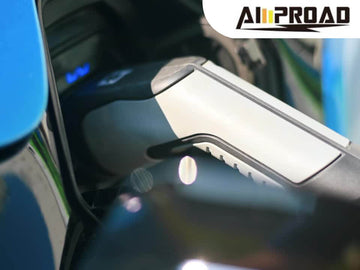
EV charging decisions are crucial for maintaining battery health and longevity. Understanding the impact of charging percentages is key for balancing convenience with battery preservation. This article explores whether charging an EV to 80% or 90% is more beneficial. These choices affect daily usage and long-term performance, highlighting the importance of thoughtful charging practices. By examining the pros and cons of each approach, EV owners can make informed decisions that promote both efficient driving and battery health.
Why Consider Charging to 80 or 90?
Understanding the significance of choosing to charge an electric vehicle (EV) to either 80% or 90% involves a careful consideration of battery health and longevity. The 80% charging threshold is often recommended as an optimal choice for preserving the battery. Charging to 80% allows for a more controlled charging process, reducing stress on the battery cells and minimizing the risk of overcharging. This deliberate approach aims to extend the lifespan of the battery by mitigating factors that contribute to degradation over time.
On the other hand, opting for a 90% charge provides a slightly higher capacity for the EV's battery, catering to drivers who require a longer driving range on a single charge. While this choice offers more flexibility in terms of immediate range, it comes with trade-offs related to battery wear. Charging an EV to 90% involves subjecting the battery to higher stress levels during the charging process, which may contribute to a faster decline in overall battery health over the vehicle's lifespan.
The role of a level 2 EV charger becomes crucial in these charging decisions. Level 2 chargers are commonly used for home charging and public charging stations, offering faster charging times compared to standard household outlets. The charging level chosen influences the rate at which an EV reaches its desired capacity. By grasping the impact of the 80% and 90% charging thresholds and considering the role of the level 2 EV charger, EV owners can make informed decisions tailored to their driving needs and long-term battery care.

What Does Charging to 80% Mean for EV Batteries?
Charging an electric vehicle (EV) to 80% entails a deliberate strategy aimed at balancing the convenience of immediate range with the preservation of the battery's long-term health. By adhering to this charging limit, EV owners can experience several benefits. Firstly, charging to 80% reduces stress on the battery cells during the charging process, minimizing the risk of overcharging and heat generation. This controlled approach helps mitigate two factors known to contribute significantly to battery degradation, thereby extending the overall lifespan of the EV battery.
While the 80% charging limit provides advantages in terms of battery health, it does come with considerations for daily driving. EV drivers need to be mindful that the immediate driving range may be slightly reduced compared to a full charge. However, this trade-off becomes a strategic choice, allowing drivers to strike a balance between a practical daily range and the long-term sustainability of their EV's battery. Understanding the implications of this charging limit is particularly relevant for those using the fastest home EV charger, as it empowers users to optimize charging times while prioritizing battery longevity. This knowledge equips EV owners to make informed decisions that align with both their immediate driving needs and the overarching goal of maintaining a healthy and durable battery.
Is Opting for 90% Charging a Balanced Choice?
Choosing to charge an electric vehicle (EV) to 90% presents a balanced choice that offers advantages but comes with potential trade-offs. Opting for a higher charging limit provides users with a more extended immediate driving range, accommodating those who require the flexibility for longer journeys on a single charge. This choice is particularly relevant for individuals with specific driving patterns or those who need the extra range for occasional road trips or extended commutes.
However, this balanced choice involves considerations related to battery health and long-term performance. Charging an EV to 90% subjects the battery to higher stress levels during the charging process, potentially accelerating the rate of degradation over time. The increased stress and heat generated during this higher charging limit may contribute to a faster decline in overall battery health. EV owners making this choice should be aware of these trade-offs and weigh them against their individual preferences and driving patterns.
The role of the level 2 charger is crucial in this decision-making process. Level 2 chargers, commonly used at home and public charging stations, provide faster charging times compared to standard outlets. Users opting for a 90% charge can leverage the efficiency of a level 2 charger to reduce the time spent at the EVCS while still benefiting from the extended driving range. This aligns with user preferences for convenience and flexibility while emphasizing the need to strike a balance that considers both immediate driving needs and the long-term well-being of the EV's battery.
How Do Charging Habits Affect EV Battery Lifespan?
Charging habits play a pivotal role in determining the overall lifespan and health of electric vehicle (EV) batteries. Beyond the specific choice between 80% and 90% charging, factors such as temperature, charging frequency, and the charging infrastructure used contribute to the broader impact on battery longevity. Temperature, for instance, significantly influences battery performance. Extreme temperatures, whether too high or too low, can accelerate battery degradation. EV owners should be mindful of environmental conditions and take measures to optimize charging sessions within a moderate temperature range.
The frequency of charging also influences battery wear. While modern EV batteries are designed to handle frequent charging, excessive use of fast chargers or consistently draining the battery to very low levels can contribute to premature aging. Striking a balance between regular charging and avoiding extreme states of charge is crucial for maintaining optimal battery health. In this context, the choice of a level 2 EV charger becomes pertinent. Level 2 chargers, commonly found at home and public charging stations, offer a balance between charging speed and battery-friendly practices. The controlled power delivery of level 2 chargers helps manage temperature rise during charging, contributing to a more favorable environment for the battery.
Considering the broader context of charging habits provides a holistic approach to ensuring the longevity of EV batteries. Owners can enhance their battery's health by being mindful of temperature conditions, moderating charging frequency, and leveraging the advantages of a level 2 home EV charger. This approach not only promotes sustainable battery practices but also ensures a reliable and efficient driving experience over the life of the electric vehicle.

Are There Manufacturer Recommendations for Charging Limits?
Electric vehicle (EV) manufacturers often provide valuable guidelines regarding optimal charging percentages to enhance battery health and overall performance. These recommendations serve as a roadmap for EV owners, guiding them towards practices that align with the design and capabilities of the vehicle's battery. While specific charging limits may vary among manufacturers, adhering to these guidelines is not only beneficial for the longevity of the battery but also plays a crucial role in maintaining warranty coverage.
One notable example of a versatile EV charger that aligns with manufacturer recommendations is the Amproad EV charger. Amproad's charger stands out as a dual-purpose solution that seamlessly transitions between level 1 and level 2 charging. The charger's adaptive voltage range of 90-250, coupled with customizable current options ranging from 10 to 40 amps, empowers EV owners with a flexible charging solution. This adaptability ensures compatibility with different power sources and diverse charging scenarios, allowing users to optimize charging speed based on their specific requirements.
Adhering to the manufacturer's recommendations for charging limits is particularly relevant for preserving warranty coverage. EV manufacturers often specify charging limits to ensure optimal battery performance and minimize the risk of accelerated degradation. By following these guidelines, EV owners not only promote the longevity of their vehicle's battery but also safeguard their warranty agreements. The Amproad EV charger, with its adjustable amp ratings and dual-purpose functionality, exemplifies a charging solution that aligns with both manufacturer recommendations and the diverse needs of EV owners.
Understanding and respecting the charging limits recommended by manufacturers is a proactive step towards responsible EV ownership. It not only contributes to the overall health and longevity of the battery but also assures users that their investment is protected under warranty. As the electric vehicle landscape continues to evolve, the collaboration between manufacturers and innovative charging solutions like Amproad's highlights the commitment to sustainable practices that benefit both EV owners and the longevity of their vehicles.
Balancing Convenience and Battery Health in Electric Vehicles
In closing, the choice between charging an electric vehicle (EV) to 80% or 90% involves a careful consideration of immediate driving needs and long-term battery health. Opting for the 80% threshold offers benefits in terms of minimized stress on the battery, contributing to extended overall battery lifespan. On the other hand, choosing 90% provides a more extended immediate driving range but may impact long-term battery health. EV owners can navigate this dilemma by understanding their driving patterns, leveraging the capabilities of a level 2 EV charger like Amproad's versatile solution including the level 2 portable EVSE, and adhering to manufacturer recommendations. Ultimately, making an informed decision tailored to individual circumstances ensures a balance between convenience and sustainable battery practices.


